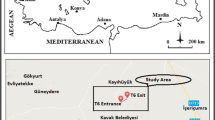Abstract
Systematic rock mass characterization is an integral part of rock engineering practices. In the present scenario several classifications are in used for rock mass characterization for tunnelling. The present paper discusses engineering geological investigations carried out for Punasa tunnel, a part of Narmada Sagar project. The horse shoe shaped tunnel is 3675.25 m long and 9 m in diameter. This straight and free flow tunnel has been constructed in basaltic lava flows erupted during Cretaceous to Eocene age, belonging to poor to fair rock mass rating (RMR) and extremely poor to good in tunnel quality (Q-system). The values of RMR and Q-system ranges from 29 to 74 and 0.0825 to 13.33 respectively.
Similar content being viewed by others
References
Ahmed, M.J. and Pathak, S.K. (1999) Geotechnical appraisal of river diversion arrangement of Narmada Sagar Project, district Khandwa, (M.P.). Indian Soc. Engg. Geol., v.VI, pp.126–130.
Barton, N., Lien, R. and Lunde, J. (1974) Engineering classification of rock masses for the design of tunnel support. Rock Mechanics, v.16, pp.189–236.
Bieniawski, Z.T. (1973) Engineering classification of jointed rock masses. Trans. S. African Inst. Civil Engin., v.5, pp.335–343.
Bieniawski, Z.T. (1974) The geomechanics classification of rock masses and its application in tunnelling. Proc. 3rd International Conf. on Rock Mechanics, Denver, v.II A, pp.27–32.
Bieniawski, Z.T. (1979) The geomechanics classification in rock engineering application. Proc. 4th International Congress on Rock Mechanics. ISRM, Montreux, Balkema, Rotterdam, v.2, pp.41–48.
I.S. Code 5878 (1971) (Part II/Sec1) Indian Standards code of practice for tunnel excavation in rock, section 1-Drilling and blasting (Reaffirmed 2000).
I.S. Code 5878 (1971) (Part II/Sec2) Indian Standards code of practice for tunnel excavation in rock, section 2-Ventilation, lighting, mucking and dewatering (Reaffirmed 2000).
I.S. Code 5878 (1971) (Part II/Sec3) Indian Standards code of practice for Underground excavation in rock, section 3-Tunnelling method for steeply inclined tunnels, shaft and underground powerhouse (Reaffirmed 2000).
I.S. Code 5878 (1972) (Part III) Indian Standards code of practice for construction of tunnel. Underground excavation in soft strata (Reaffirmed 2000).
I.S. Code 5878 (1971) (Part IV) Indian Standards code of practice for construction of tunnel. Tunnel support (Reaffirmed 2000).
I.S. Code 5878 (1972) (Part VII) Indian Standards code of practice for Grouting (Reaffirmed 2000).
I.S. Code 4756-1978 Indian Standards code of practice for safety code for tunnelling (Reaffirmed 2007).
Author information
Authors and Affiliations
Corresponding author
Rights and permissions
About this article
Cite this article
Gupta, M.C., Singh, B.K. & Singh, K.N. Engineering geological rock mass classification of Punasa tunnel site, Khandwa District, Madhya Pradesh. J Geol Soc India 77, 269–272 (2011). https://doi.org/10.1007/s12594-011-0034-3
Received:
Accepted:
Published:
Issue Date:
DOI: https://doi.org/10.1007/s12594-011-0034-3




